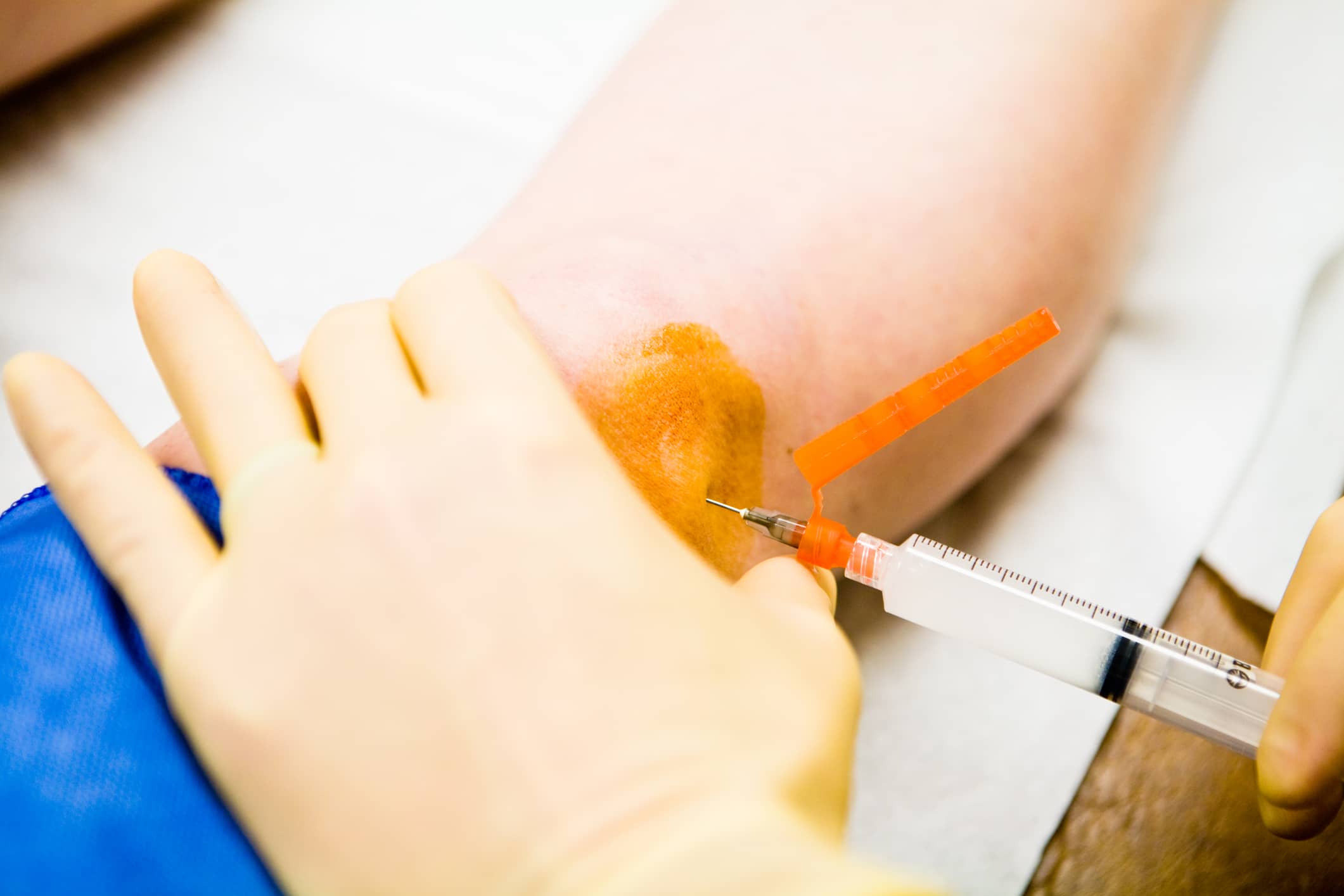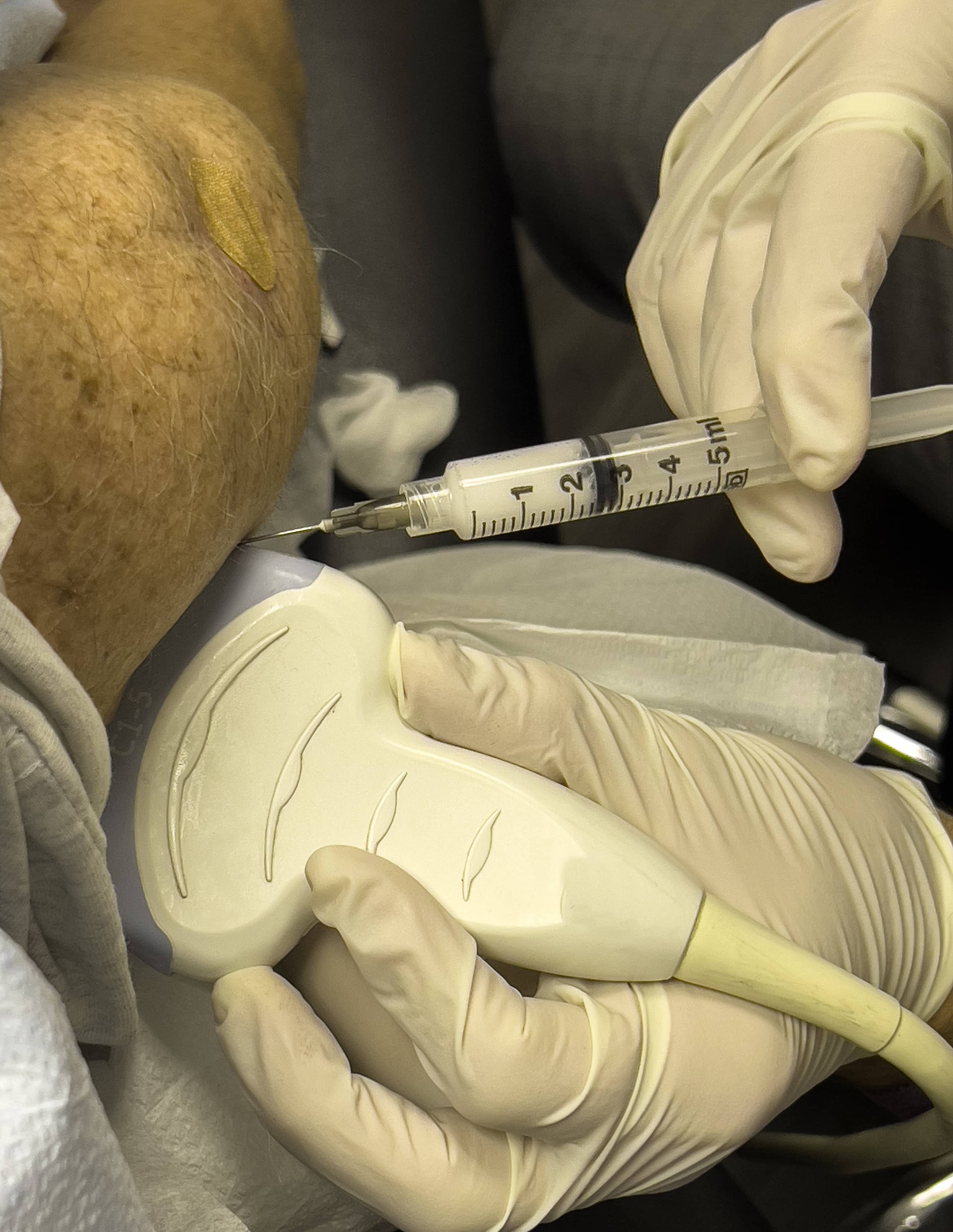Treatment
Cortisone Shot (Steroid Injection)
A cortisone shot is a simple in-office procedure in which a steroid, like triamcinolone or methylprednisolone, is injected into a joint in combination with an anesthetic, like lidocaine or bupivacaine. Because the shot includes steroids, it is sometimes called a "steroid injection."
A cortisone shot can be given by a primary care doctor, sports medicine doctor, orthopaedic surgeon, or other healthcare professional with experience in joint injections.
Which Conditions Are Cortisone Shots Used To Treat?
Cortisone shots help to reduce the pain associated with many joint conditions, such as arthritis and bursitis, as well as carpal tunnel syndrome and back pain. They are used in a variety of joints, including the shoulder, elbow, wrist, hip, knee, and ankle.
How Does a Cortisone Shot Work?
The injectable steroid used in a cortisone shot has anti-inflammatory properties.
The injectable steroid is deposited on the lining of the joint. As the cells in the lining of the joint interact with the injectable steroid, the cells begin to work with your immune system to reduce inflammation and pain.
Here are some important things to know about how the injection works:
- It takes a few days for a cortisone shot to kick in as the cells in the lining of the joint interact with the injectable steroid. This delay is why a cortisone shot is usually combined with an anesthetic, like lidocaine or bupivacaine, for faster pain relief.
- There is a risk of a "flare" after a cortisone shot, where the pain may get worse for 1 to 2 days before the steroid takes effect.
- A cortisone shot can last for several weeks as the cells in the lining of the joint continue to interact with the injectable steroid. This allows a cortisone shot to improve joint function by reducing the pain that limits movement.
Why Get a Cortisone Shot?
There are other types of injections, such as platelet-rich plasma (PRP) and stem cells, that a doctor or provider might consider when treating joint pain.
However, only a cortisone shot can be combined with an anesthetic to help your provider understand the underlying cause of joint pain.
Joint pain can come from inside or outside the joint. Many surgical treatments, like arthroscopy or arthroplasty (joint replacement), only address pain inside the joint. This makes a cortisone shot a powerful test when considering future surgery, even if the pain relief is not long-lasting.
- If there is significant pain relief immediately after a cortisone shot, it confirms pain is coming from the joint and can usually be addressed with surgery.
- If there is minimal or no immediate relief, it may indicate that cortisone shot missed the intended joint. This is why many doctors and providers use ultrasound or fluoroscopy to guide their injections. Even with image guidance, the shot can still be given in the doctor's or provider's office.
- If the cortisone shot is confirmed to be inside the joint and there is minimal or no immediate relief, it confirms that the pain is due to a source outside the joint, such as a fracture, ligament or tendon injury, or neuromuscular damage. Many forms of joint pain can come from other areas, such as another joint or the lower back. A cortisone shot into a joint that does not provide satisfactory pain relief should prompt your doctor or provider to look for issues in other areas of the body that can mimic joint pain.
How Effective Is a Cortisone Shot?
A cortisone shot is considered an effective treatment option for many patients suffering from joint pain — especially if less invasive treatments, such as oral medications and physical therapy, have not provided sufficient relief.
The effectiveness of a cortisone shot depends on whether the pain is coming from inside or outside the joint (see Why Get a Cortisone Shot above).
It is important to note that while a cortisone shot can effectively manage pain coming from inside the joint, it does not cure the underlying cause of the inflammation. Because the condition does not go away and is likely to progress if not treated, repeated injections may become less effective over time.
How Often Can You Get a Cortisone Shot?
There is no formal limit on the number of cortisone shots you can receive, and the frequency will depend on the patient’s specific circumstances.
Often, doctors and providers set a practical limit of 3 to 4 cortisone shots per year. Once a patient exceeds these limits, surgery may be a better option to avoid the diminishing returns for pain relief and the potential increased risk of infection and other complications, like tendon tears, from additional injections.
Does a Cortisone Shot Affect Future Surgery?
While cortisone shots are effective at reducing inflammation and pain, they also have an adverse (negative) effect on chondrocytes, the cells responsible for maintaining a smooth joint surface. This can accelerate the progression (worsening) of arthritis.
This is important to know if you are considering joint restoration treatments, such as microfracture or autologous chondrocyte implantation, since a cortisone shot may decrease the likelihood of success after regenerative techniques. Joint restoration aims to preserve existing cartilage, so your doctor or provider may prohibit or limit cortisone shots prior to a joint restoration procedure.
The adverse effect on chondrocytes is less relevant if you are considering joint replacement. A joint replacement involves removing damaged cartilage and bone and replacing them with metal and plastic components. Since the entire joint surface is replaced, the condition of the cartilage and any additional damage caused by cortisone shots will not affect the joint replacement outcome.
However, if you get a cortisone shot in a joint, replacement surgery in that joint should be delayed for at least 3 months to minimize the risk of infection.
Are There Any Other Side Effects or Risks?
As described above, cortisone injections over time can potentially lead to cartilage deterioration. These are some other risks and potential side effects.
Very little injectable steroid escapes the joint. As a result, patients rarely experience the whole-body side effects that are typically associated with steroids taken by mouth, like loss of bone density and weight gain. That said, a small amount of the injectable steroid does escape the joint and can result in temporarily elevated blood sugar readings in patients with diabetes. Long-acting injectable steroids have been designed to reduce this blood sugar elevation but do not increase the effectiveness of a cortisone shot when it comes to pain relief.
A cortisone shot should generally not be used for tendinitis, since it can increase the chances of a tendon rupture, especially when used for biceps, patellar, or Achilles tendinitis. Depending on the skill of the practitioner and where the injection is placed, an injection may miss the joint space. If this happens, the cortisone may not effectively reach the targeted area, resulting in little to no symptom relief. Ultrasound guidance can help reduce the risk of missing the joint space.
Because an injection goes through the skin, there is a very small risk of infection. Sterile techniques are essential to minimize the risk of local infection during a cortisone shot. A joint infection, if it occurs, can be serious and require immediate medical attention.
Contributed and/or Updated by
Peer-Reviewed by
AAOS does not endorse any treatments, procedures, products, or physicians referenced herein. This information is provided as an educational service and is not intended to serve as medical advice. Anyone seeking specific orthopaedic advice or assistance should consult his or her orthopaedic surgeon, or locate one in your area through the AAOS Find an Orthopaedist program on this website.








